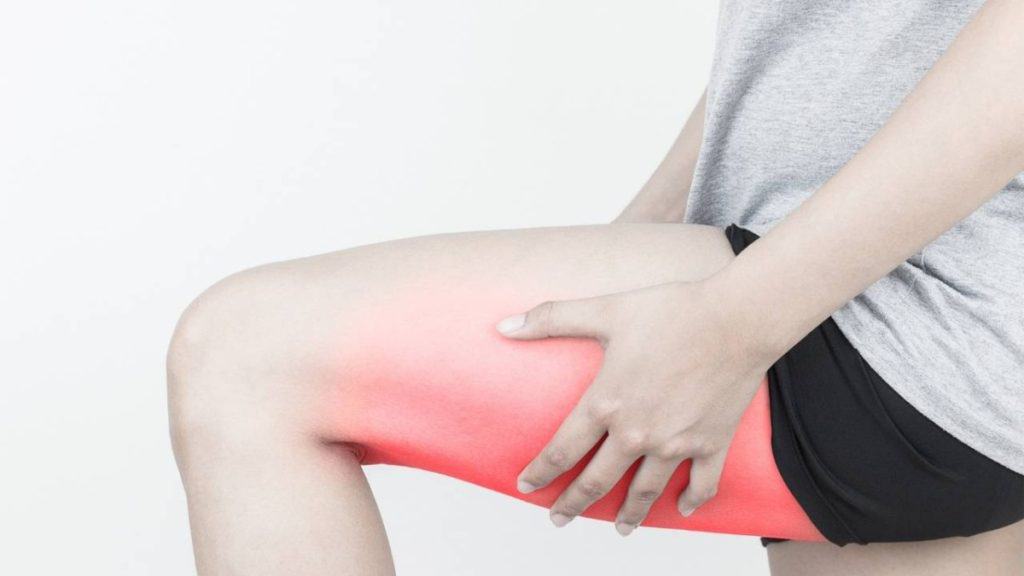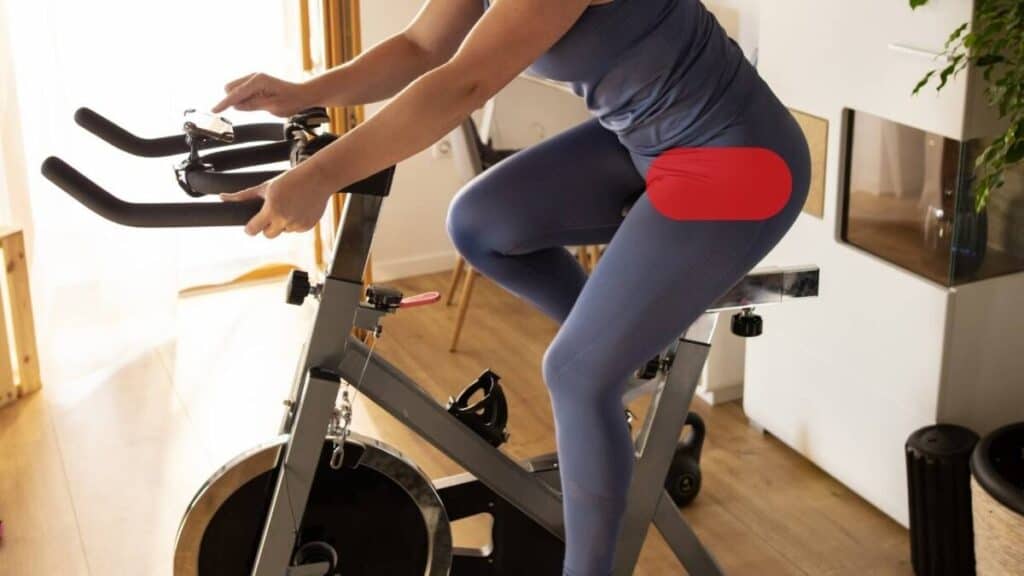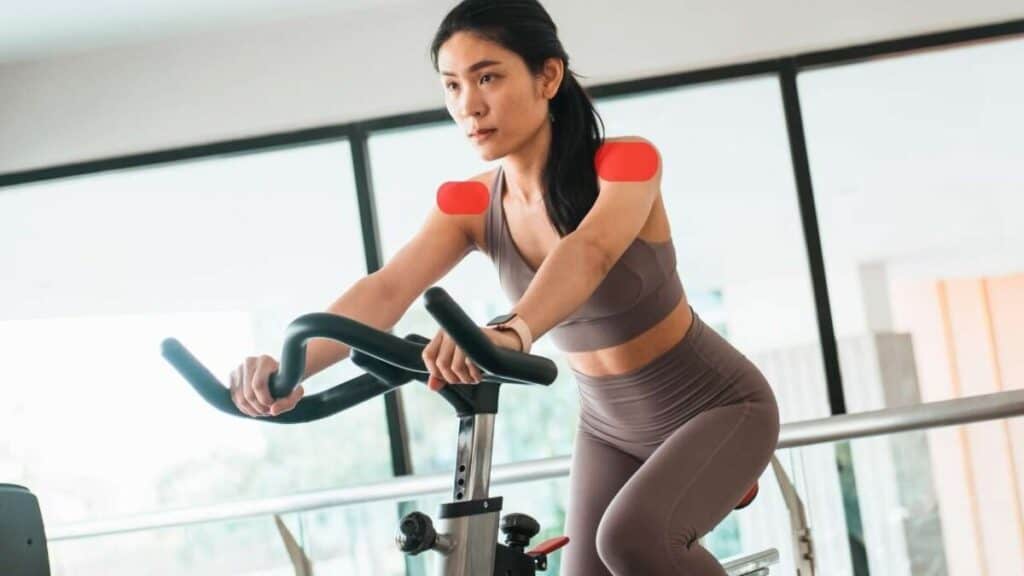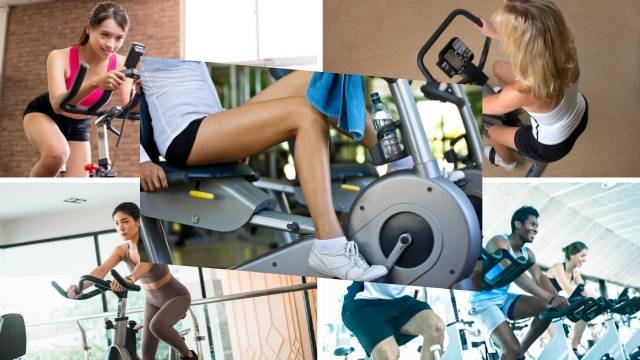
Regardless of the type of exercise bike you ride, be it a stationary bike, upright bike, recumbent exercise bike or a spin bike, they all work specific muscles in your body. Most people assume that riding a stationary exercise bike activates only your leg muscles, but it’s far from true. You recruit and engage most of the muscles in your entire body, making an exercise bike a great workout for weight loss, improving cardiovascular fitness and significantly boosting your fitness levels.
Table of Contents
11 Muscles Stationary Exercise Bikes Work
Riding an exercise bike is a great form of low-impact exercise, so if you have back pain or knee pain, it’s definitely recommended. The number of muscle fibres you engage will depend on your workout routine. If you follow an indoor cycling workout plan or use a 3rd party app like Peloton or Les Mills for your class, you will probably use more muscle than steady-state riding without any hill climbing or sprints.
To get the most out of your exercise bike to use the most amount of muscle, I recommend having an exact workout planned for each session. But if you just want to ride to improve your fitness level, burn calories and have less stress, an exercise bike is still the ideal aerobic exercise.

1. Hamstrings (Thighs)
Your hamstring is the muscle at the back of your upper leg. It’s a large muscle attached to the glutes and rear of your knee. Your hamstring will tighten and release through the motion of riding a stationary bike. Building your hamstring muscles is vital to ensure you protect the surrounding bones and joints, but they can become very tight if overused.
When you’re riding an exercise bike, each time you pull your leg up after the rotation of your pedal, your hamstring is engaged. The heavier the resistance, the more hamstring your recruit. Over time your hamstring becomes toned, and you add extra muscle because the fibres are broken down after your workout. When you rest and recover, the muscle rebuilds and becomes stronger.
Not only is it necessary to nourish and exercise the muscles in your legs, but it’s also essential to stretch out the muscles before and after your cycling workout to loosen them up. Having tight hamstrings can also extend pain to your lower back, knee pain and joint problems.
2. Quadriceps (Back of the Thigh)
Your quadriceps are the front of the leg and is the second-largest muscle in your body. The quads are one of the major muscle groups made up of 4 individual muscles that are all connected. Similar to your hamstrings, they surround a lot of bones and joints, and thus, making them stronger is ideal for rding.
The quads are the most dominant muscle when you’re cycling an exercise bike and take the most oxygen, blood, and energy to work out. Therefore, during a workout or interval training, you need to make your quads work hard if you want to maximise calorie consumption. The output (wattage) you produce mainly comes from your quad muscles, so if you’re going to push out more power on your upright bike, you need to build your quads.
It’s also important to stretch your legs before exercising so your quadriceps get loosened up along with the rest of your leg muscles. Just like your hamstrings, your quadriceps will tighten and release while your cycling, helping them to get good circulation and power. A seated bike session at higher resistance or interval training (HIIT) will work the quads more than standing hill climbs.
3. Gluteus Maximise (Glutes)
Your glutes are the muscles that make up your bum area. Three glute muscles, the gluteus minimus, the gluteus maximus, and the gluteus medius, will strengthen during an indoor ride. The glutes are one of the most desirable body areas that women what to shape and tone the most.
Working out your glute muscles will obviously help firm up the look and feel of your bum, but it also does so much more. Having strong and healthy glute muscles can help improve your posture. They can also help strengthen your pelvis, which is super important if you are a woman.
Furthermore, your hips will get a lot more support from some strong glutes. Your glutes and hips are actually what help power your exercise bike, even more so than your legs, so the engagement you get in these areas is better than many other workouts. The movement of standing and sitting during an exercise class activates the glutes. So, pick a class with lots of movement on and off the saddle.

4. Lower Back
Having a strong lower back is so very crucial to your day-to-day comfort. So many people suffer from back pain, and it can be detrimental to your physical and mental health. Using a recumbent exercise bike regular can help reduce the pain in your lower back without too much pressure.
The extra back support on a recumbent bike is better if you suffer from back pain than using an upright bike or spin bike. Once you build your stabiliser muscles and get fitter and stronger, you can move to an upright exercise bike.
Stationary cycling will help you engage those lower back muscles and keep them strong and healthy. Occasionally leaning forward while supporting your shoulders will help stretch out those muscles while you’re strengthening them. On the occasions when your class has more sitting, make sure you keep your back straight to avoid straining it.

5. Calve Muscle (Lower Leg)
Your calf muscles are the muscles in the bottom portion of your lower legs. These crucial muscles also get some power through cycling. Being that calves are really easy to injure through other activities, it’s crucial to work out these muscles. Using a spin bike is easy to do this without potentially straining your calves.
Each time you push down on the pedal, you engage the calve muscles. The harder you push, the more they fire and activate. Your calfs can take a lot of punishment and don’t tire as quickly as other leg muscles. Even though your calves work hard, they can become incredibly tight, so you need to regular strength and loosen them to prevent injury, so use proper form.

6. Heart
Some people might forget that your heart is a muscle. When you are engaging in cardio workouts, which upright stationary cycling is, you are helping your heart exercise as well. You are helping your heart get stronger in order to help it pump blood to the rest of your body efficiently, which significantly improves your cardiovascular health.
Cardiovascular exercise is one of the most beneficial things about exercing, and when you can improve your cardio health, your whole body, mind and organs thrive. The benefits of regular cardiovascular exercise are manifold and far-reaching. To name a few:
- Improves your cardiovascular system.
- Decreases risk of cardiovascular disease, high blood pressure and high cholesterol.
- Increases heart health in general, which means it can prolong life for years to come.
- Increases metabolism, helping you burn more calories every day.
- Increases bone density (reduces the risk of osteoporosis)
- Increases energy levels and boosts feel-good hormones, creating an overall happier you.
- Reduces stress.
- Improves circulation (including blood flow to the brain). This has several benefits, including increased learning capacity (less mental fog), heightened creativity and better memory recall.
- Enhances your mood, making you feel calmer and more even keel.
- It Burns a ton of calories in a short amount of time (one hour can burn at least 500 calories!)
- Increases coordination and balance. This is especially important as we get older to help prevent falls that can break bones or cause serious injury.
- Improves sleep.
And the list goes on…and on….and on! Of course, depending on your age, health and fitness goals, the benefits you receive will vary but working out on an exercise bike for as little as 20 minutes every day can bring fantastic health advantages. Find out is 20 minutes on exercise bike enough.

7. Abdominal Muscles (Abs)
Your core is situated in the middle of your body. A strong core is beneficial for the rest of your body. A stationary bike helps you engage your abs, so long as you keep the right posture while you’re cycling away.
Your best bet to ensure your core is being strengthened is to make sure you are sitting up straight while on your bike. You also want to hold your stomach muscles firmly but not too tight so that it makes you feel sick. The best way to do this is to push your belly button into your back using the muscles in that area.
Another way to help yourself strengthen your entire core as you work out on your bike is to incorporate side crunches into your workout routine. This will help strengthen the muscles at the sides of your core, right above your hips. You don’t need to add extra weight just your body weight will work.

8. Biceps & Triceps (Arms)
Most exercise bikes will have handles that move, but some don’t. However, the majority have 3 different hand positions depending on the type of bike you are using. You might be surprised to discover you are using a lot of arm muscles when you’re on your stationary bike. You often use the handlebars to steady yourself while cycling, which is engaging them, even if it’s only lightly.
Some spin classes will also incorporate arm workouts into their routines to help maximise your time on the spin bike as much as possible. This also helps you get a full-body workout using one machine. You can even work in some light arm weights to sculpt those arm muscles even more while you’re on your bike.

9. Hip Flexors
The hip flexors are a group of muscles at the front of your thigh that allows you to lift your knees and bend at the hip joint. These muscles are located in the front of the hip and the top of the thigh. To work them on an exercise bike, try peddling at high resistance with your knees lifted so that your thighs are parallel to the ground.
These muscles are some of the most important in the body, and they can be easily injured if they are not properly stretched and strengthened. The hip flexors are used every time you get on the exercise bike, and they are especially important when you are cycling fast.
When these muscles become weak or tight, it can lead to pain in the lower back, hips, and knees. In severe cases, it can even cause problems with balance and mobility. That’s why it’s so important to stretch and strengthen your hip flexors on a regular basis.

10. Shoulder Muscles
The shoulder muscles include the deltoids, trapezius, and rotator cuff muscles. These muscles allow you to raise your arms overhead and rotate your arms. They get worked hard on an exercise bike, especially if you do a lot of standing hill climbs or cycle your bike hard.
The shoulders stabilise your upper body when you ride at a threshold pace sat on the seat for long intervals. If you don’t have strong should muscles you will rock more, making you less efficient when riding an exercise bike. You don’t need to grip the handlebars to work your shoulders.
In fact, it’s better to have a loose grip on the handlebars and use your shoulders to balance and lower upper body movement. Some exercise bikes have lower handlebars, similar to road bikes or spin bikes. Your shoulder works even harder if you use this hand position which is a great option.
11. Full Body Workout
An exercise bike can also be used for a full-body workout. For this, try pedalling at a moderate to high resistance with your hands on the handles and your feet on the pedals. You should feel like you are working your entire body when doing this.
Your lower body is the most obvious group of muscles that you work when you’re riding an exercise bike. Your leg muscles account for 75% of the muscle’s activation when you ride an exercise bike.
However, you still active a good amount of upper body muscles, so it’s not necessary a lower body exercise. Therefore, it’s important if you want to be faster and more efficient on an exercise bike that you work your upper body muscles as well as your leg muscles. I recommend a full-body strength workout with moderate weights 3 times a week to supplement your exercise bike training.
What Muscles Do Exercise Bikes Work Summary
A stationary bike will predominately use leg muscles like the thighs, hamstrings, gluteus maximise and lower legs, but they still use some upper body muscles like the arms and shoulders. An upright bike is a great way to lose weight, burn extra calories and reduce stress, so it’s highly recommended to everyone. If your looking for low-impact cardiovascular exercise, then an indoor bike is a fantastic option, especially for a home gym.





